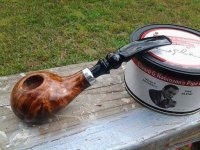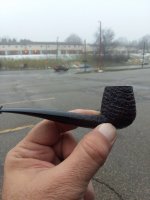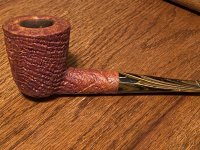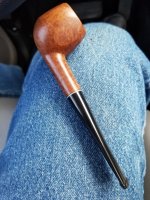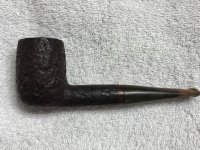Excellent information. I know a lot of the clays I used to find in the Thames as a kid had the stems broken down to only a few inches to make for easier clenching whilst working with both hands on the old ships (you could find teeth marks on some). I know a lot of the skulls found from those days have their teeth worn away in a circle from the wear of the clay against the enamel where they worked with their pipe clenched all day for years. The working classes rarely used the Churchwardens as is, generally they broke the stem down to suit their personal needs. Keep the info coming please it’s fascinating.I & Co. in a horizontal diamond stamped on the shank (the mark for Inderwick & Co. 1797-2000)
E.I over G.I over H.J.I stamped on the mount
View attachment 62183
with marks for London 1900
+ Dunhill FLAKE
View attachment 62246
Watching WITNESS FOR THE PROSECUTION
Inderwick & Co. were also dealers in clay pipes but on clays the stamp was incuse INDERWICK instead of I & Co.
Below is a mid-late 19th cent. example - with slightly later band repair and horn stem - alongside another typical Burns Cutty of the period with similar band repair and stem by T. Milo (Theophilus Milo operated in Finch Lane in the City of London between 1860 and 1870 and was also in business as a tobacconist in the Strand) as well as three examples of the typical Burns Cutty clay from the same period alongside an early 20th cent. unsmoked example from the early 20th cent. by C. Crop & Sons (C.Crop - from the 1840s or 1856 depending on where you search to 1910 or to 1924 according to which source material you consult) complete the picture
View attachment 62247
The Clay Cutty
"In the 'fifties (1850s) the pipes smoked were mostly clays. There were the long clays or “churchwardens,” to be smoked in hours of ease and leisure; and the short clays—“cutties”—which could be smoked while a man was at work. Milo, a tobacconist in the Strand, and Inderwick, whose shop was near Leicester Square, were famous for their pipes, which could be bought for 6d. apiece. A burlesque poem of 1853, in praise of an old black pipe, says:
Famed are the clays of Inderwick, and fair
The pipes of Fiolet from Saint Omer.
(From Notes and Queries - September 27, 1913)
Colonel Harold Malet at the same time wrote -
“When I was a cadet at Sandhurst in 1855-58, Milo’s cutty pipes were quite the thing, and the selection by cadets of a good one out of a fresh consignment packed in sawdust was eagerly watched by the ‘Johns.’ (Major-General John Le Marchant, first Governor of the Royal Military College, c.1810).”
***What Are You Smoking, January 2021?***
- Thread starter jvnshr
- Start date
You are using an out of date browser. It may not display this or other websites correctly.
You should upgrade or use an alternative browser.
You should upgrade or use an alternative browser.
SmokingPipes.com Updates
Watch for Updates Twice a Week
- Status
- Not open for further replies.
Good afternoon, starting late with Peterson 2019 special reserve in the new Nording Sailor. It’s about finished so I’m packing Navy Rolls next in a MM Legend for my walk along the shore.
Going to be a long and bumpy week at work, up early since 4:30 but enjoying my first bowl now at 7:30 - just enough of a nic hit to keep my sanity: Dunhill's Elizabethan in this Doctor's Crazy Bamboozled Bent Pot.


Cornell & Diehl Old Joe Krantz in a Sasieni Perfect Ten Canadian
Good afternoon folks, MacB Classic loose cut in a Peterson's.
Enjoying now,Old Joe Krantz in corn pipe Diplomat.....................................And small cup of rum............
Good Day folks, MacB Classic loose cut in a Blakemar.
Part way through this bowl of Wilke No. 515 in a 1998 smooth straight Butz-Choquin Bistro 1501 pot with a black vulcanite saddle stem. Chatting with an old friend.
We continue with. Gawith Hoggarth & Co. » Sweet Black Cherry Twist. In corn pipe Legend Straight.............![IMG_1957[1208].jpg IMG_1957[1208].jpg](https://pipesmagazine.com/forums/data/attachments/62/62326-9b05f94f26aba70c43b87baf05215953.jpg)
![IMG_1957[1208].jpg IMG_1957[1208].jpg](https://pipesmagazine.com/forums/data/attachments/62/62326-9b05f94f26aba70c43b87baf05215953.jpg)
John Cotton’s Double Pressed VA in Mark Tinsky Bent Pot.
Good Day Folks, Three Nuns in a Rattray's.
Finishing up a bowl of C&D Oriental Silk in a cob, just got this stuff yesterday -a very fine smoke!
- Status
- Not open for further replies.







